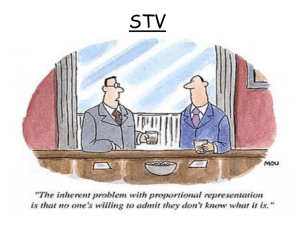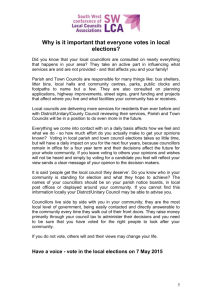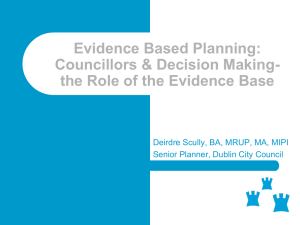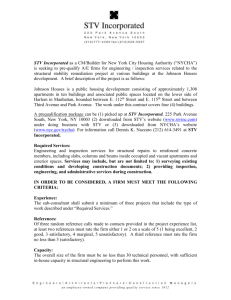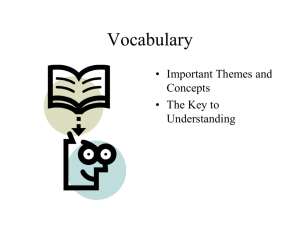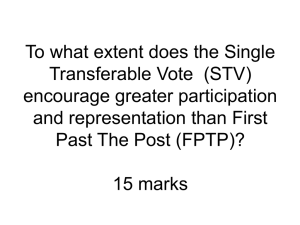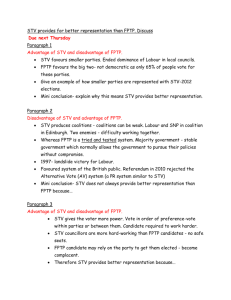Single Transferable Vote: Advantages & Disadvantages
advertisement
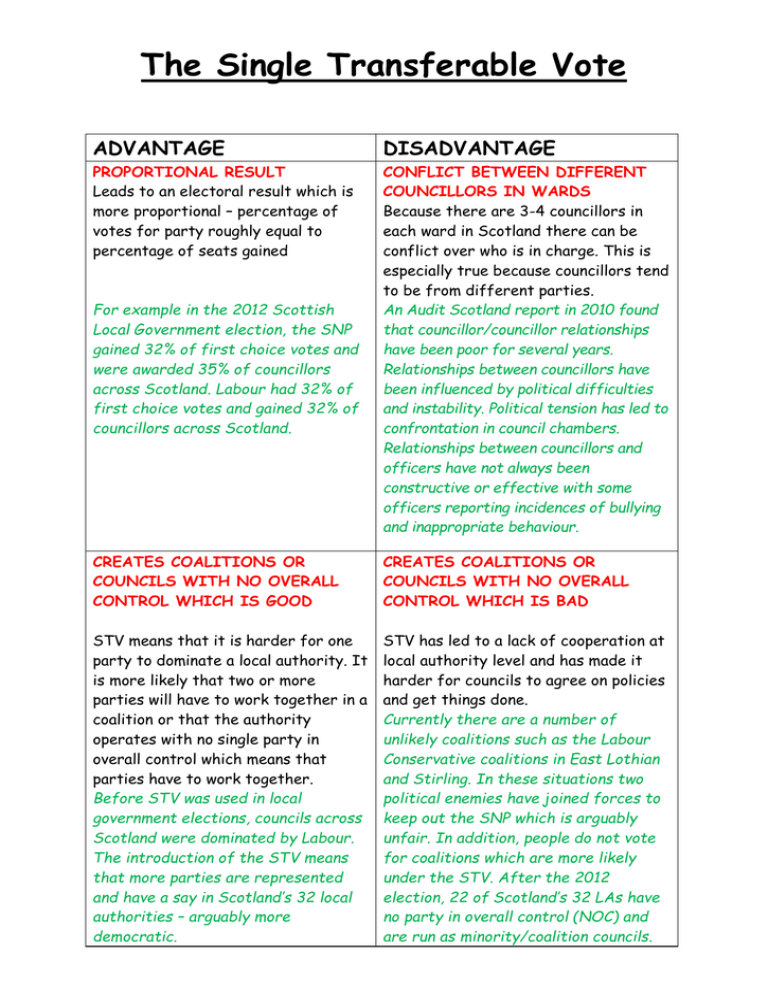
The Single Transferable Vote ADVANTAGE DISADVANTAGE PROPORTIONAL RESULT Leads to an electoral result which is more proportional – percentage of votes for party roughly equal to percentage of seats gained CONFLICT BETWEEN DIFFERENT COUNCILLORS IN WARDS Because there are 3-4 councillors in each ward in Scotland there can be conflict over who is in charge. This is especially true because councillors tend to be from different parties. An Audit Scotland report in 2010 found that councillor/councillor relationships have been poor for several years. Relationships between councillors have been influenced by political difficulties and instability. Political tension has led to confrontation in council chambers. Relationships between councillors and officers have not always been constructive or effective with some officers reporting incidences of bullying and inappropriate behaviour. For example in the 2012 Scottish Local Government election, the SNP gained 32% of first choice votes and were awarded 35% of councillors across Scotland. Labour had 32% of first choice votes and gained 32% of councillors across Scotland. CREATES COALITIONS OR COUNCILS WITH NO OVERALL CONTROL WHICH IS GOOD CREATES COALITIONS OR COUNCILS WITH NO OVERALL CONTROL WHICH IS BAD STV means that it is harder for one party to dominate a local authority. It is more likely that two or more parties will have to work together in a coalition or that the authority operates with no single party in overall control which means that parties have to work together. Before STV was used in local government elections, councils across Scotland were dominated by Labour. The introduction of the STV means that more parties are represented and have a say in Scotland’s 32 local authorities – arguably more democratic. STV has led to a lack of cooperation at local authority level and has made it harder for councils to agree on policies and get things done. Currently there are a number of unlikely coalitions such as the Labour Conservative coalitions in East Lothian and Stirling. In these situations two political enemies have joined forces to keep out the SNP which is arguably unfair. In addition, people do not vote for coalitions which are more likely under the STV. After the 2012 election, 22 of Scotland’s 32 LAs have no party in overall control (NOC) and are run as minority/coalition councils. The Single Transferable Vote MORE REPRESENTATIVES Each ward has 3-4 councillors which means that residents in wards have a choice about who to contact with concerns. TOO MANY REPRESENTATIVES Each ward in Scotland has 3-4 councillors meaning that people may be confused as to who to approach with issues. For example, in Glasgow East Centre an SNP supporter might be more likely to approach the SNP councillor in the ward, Jennifer Dunn, rather than one of the Labour councillors for the area. Using STV means that people have the option. LESS WASTED VOTES Under the STV, fewer votes are “wasted”. This is because seats are awarded proportionally rather than a “winner takes all” scenario as is the case with FPTP. For example, Glasgow East Centre ward has 4 councillors – 3 Labour and 1 SNP. Who do people contact with concerns about their area? In Westminster elections which use FPTP, thousands of votes are wasted as a party needs a majority in an area to win a seat. This means that there is less point in voting for smaller parties like the Greens and even the Liberal Democrats leading to the big parties dominating. STV ensures that seats are distributed more fairly with less people’s votes counting for nothing. CONFUSING A major criticism of the STV is that it is difficult to understand. Voters have to rank candidates in order of preference rather than simply putting an “X” next to the candidate of choice as under FPTP systems. This has led to people filling in ballot papers incorrectly in Scottish Local Government elections in 2007 and 2012. It also takes much longer to count results. Also, some people think that STV elections lead to “donkey voting” where voters just rank the candidates in the order they appear on the ballot paper. The Single Transferable Vote SMALL PARTIES REPRESENTED Under the STV, smaller parties and independent candidates have a greater chance of gaining councillors in local authorities, therefore more voices are heard representing more views. For example, currently the Green Party have 5 councillors across Glasgow City Council and 14 in Scotland as a whole. Under the old FPTP system the Greens had no chance of gaining representatives at council level. There are currently 204 independent councillors across Scotland. Typically these are local people who will do what is best for their wards and are not controlled by party politics. EXTREMIST PARTIES A major criticism of STV is that it heightens the chances of extremist parties such as the BNP gaining representation in local authorities. In the Scottish Local Government elections of 2012, many extremist parties put forward candidates. In Glasgow, the far-right Britannica Party, a splinter group from the BNP, put forward 4 candidates. Although parties such as this have not won any seats at council level in Scotland, it is much more likely to happen using the STV system as opposed to FPTP. REAL COMPETITION FOR SEATS STV means that there are fewer “safe seats”. This means that candidates have to work hard to prove themselves to voters otherwise they might be voted out. CONFLICTS WITHIN PARTIES A criticism of STV is that because members of the same party can run for the same wards they might be more likely to come into conflict with each other. Under the old FPTP system, there would only be one candidate per party and so in a Labour supporting area it would almost always be the Labour candidate that won the seat. Now because there are 3-4 councillors per ward voters are more likely to vote for individuals based on their performance, and candidates are more likely to “stay on their toes” and work harder to win election. It could be argued that a system whereby members of the same party are competing with each does not make sense. Under FPTP there would be one candidate per party for each ward – this reduces the likelihood for conflict between parties and keeps it simple for voters. The Single Transferable Vote END TO SINGLE PARTY DOMINANCE STV elections make it difficult for one party to gain an overall majority. This has ended the Labour Party’s dominance of local politics in Scotland. In 1999 when STV was still used in Scottish local government elections, Labour controlled 19 of the 32 councils in Scotland. In 2015, Labour very councils are controlled by a single party. LEADS TO WEAK GOVERNMENT It could be argued that because single party majorities are less likely, governments are weaker under STV. Coalitions and minority governments are more likely meaning that it is arguably harder to make positive changes quickly. In addition, conflicts between the different political groupings are more common. A 2013 Audit Scotland Report into Aberdeen City Council found that political feuds and infighting were preventing real progress from being made, with opposition councillors being “regularly disrespectful” to each other. The Council currently has a “rainbow coalition” of Labour, Tory and Independent councillors. Under a FPTP system this kind of coalition would be highly unlikely.
